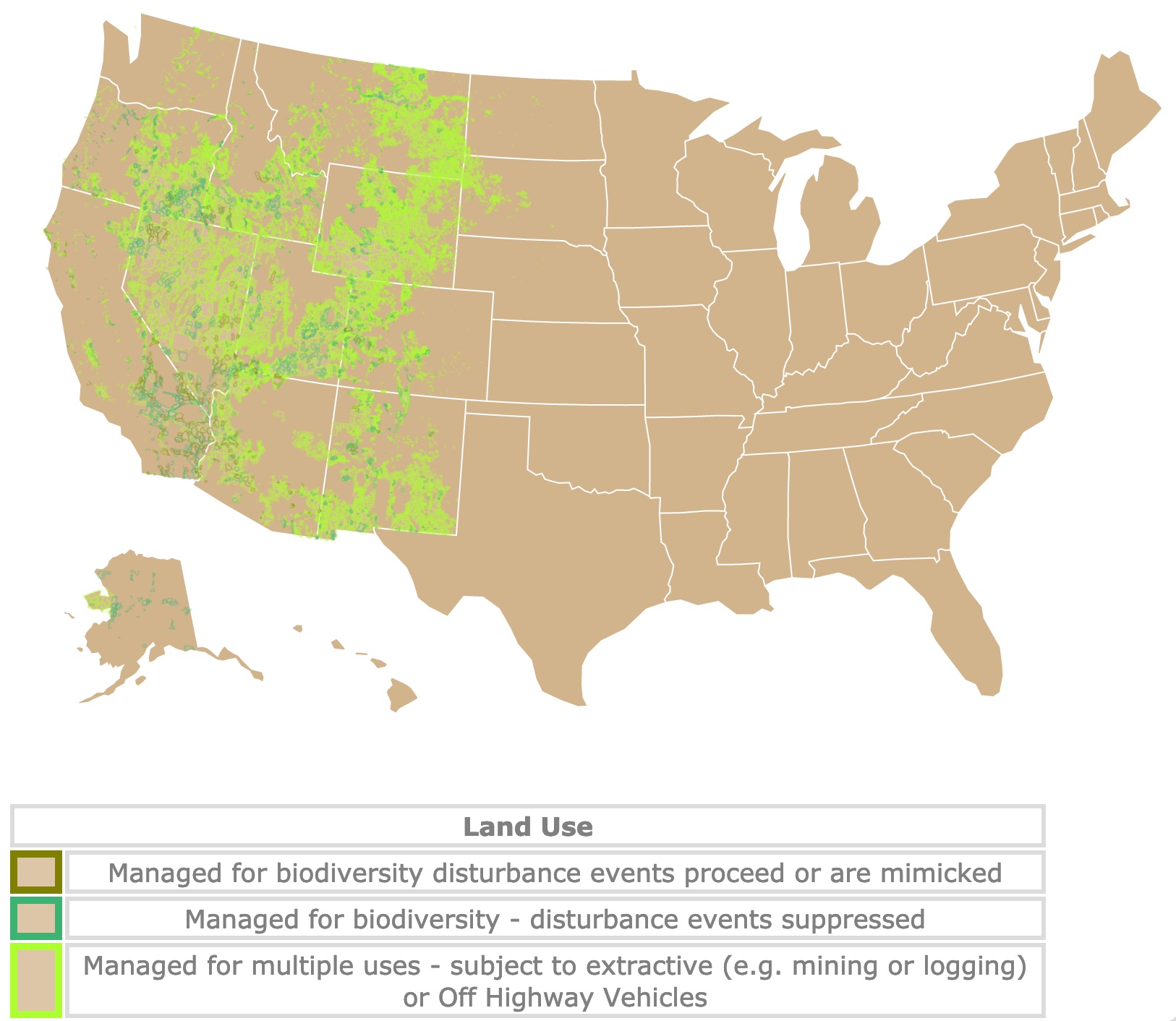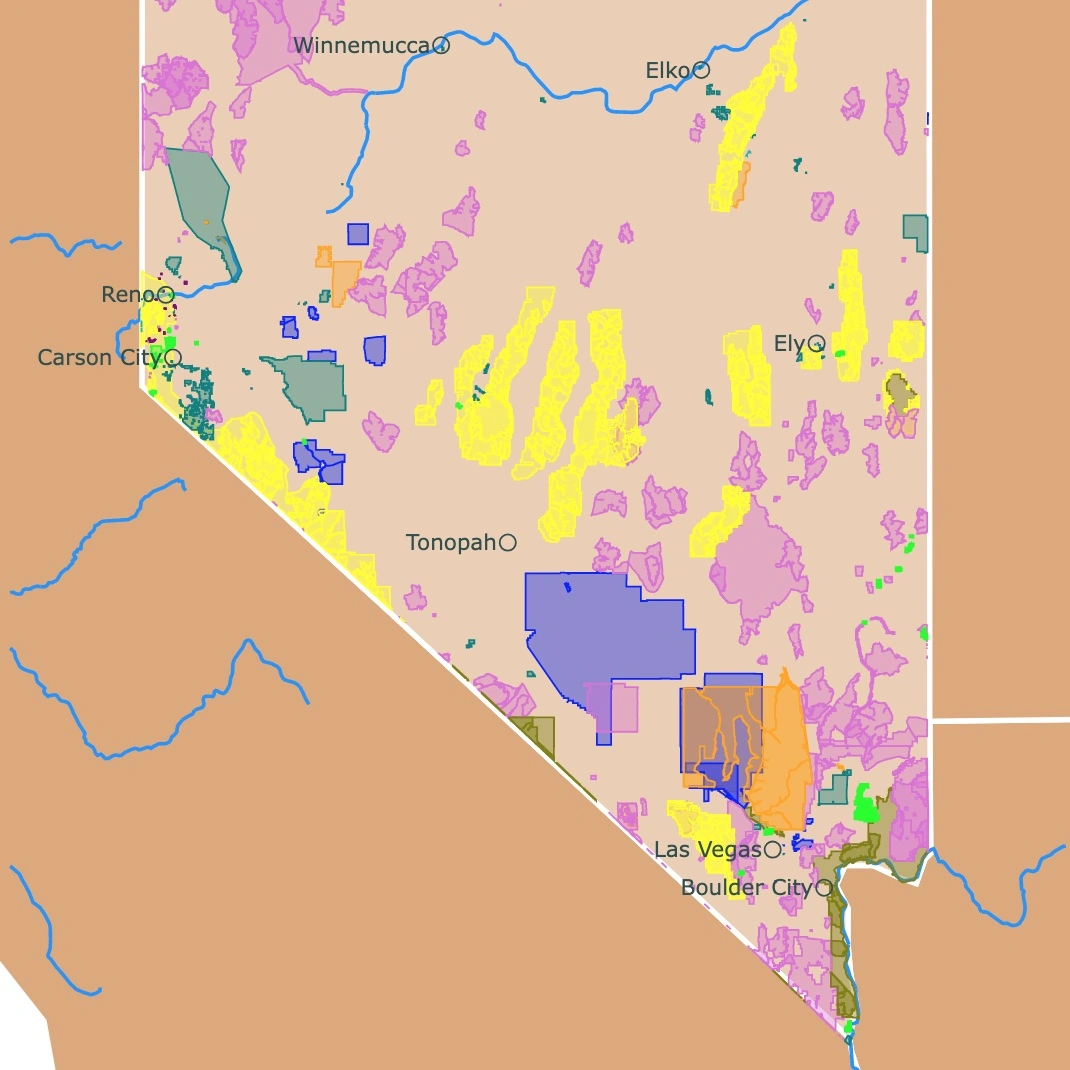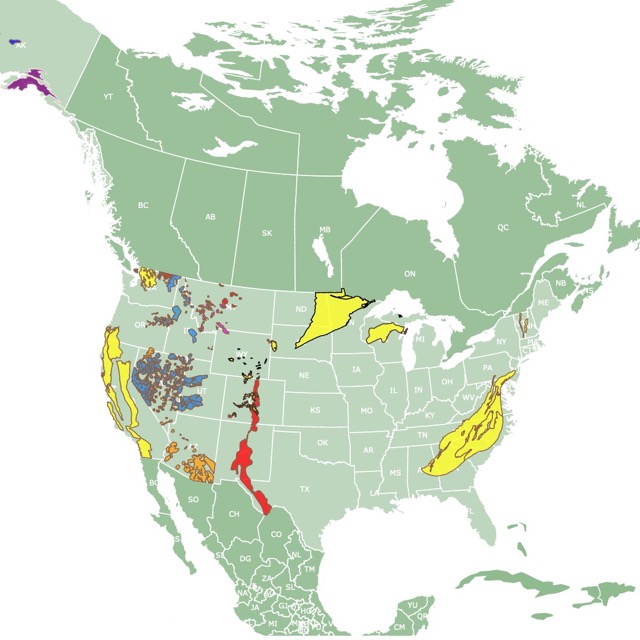Bureau of Land Management Map
This interactive map shows the Locations, Names, Area, and Uses of Public Lands managed by the Bureau of Land Management. Each polygon represents a Bureau of Land Management Unit. The color represents the Land Use. For more detail zoom in. For more information hover over the map, or scroll down.
| Land Use | |
|---|---|
| Managed for biodiversity disturbance events proceed or are mimicked | |
| Managed for biodiversity - disturbance events suppressed | |
| Managed for multiple uses - subject to extractive (e.g. mining or logging) or Off Highway Vehicles | |
Map of Bureau of Land Management
This map shows the locations of Bureau of Land Management sites. Because of the large number of sites and variety of uses, the sites were only classified into 3 types shown above.
The types are not addressed directly, but each type covers some type of use, weather it is extraction, recreation, or biodiversity preservation.
Each use is addressed in one of the programs described below.
Bureau of Land Management

The Bureau of Land Management (BLM) is an agency within the United States Department of the Interior (DOI). The BLM manages more land than any other Federal Government agency, with 256 million surface acres.
All this land, accounts to about 13 percent of the total land surface of the USA. It also accounts for more than 40 percent of the land managed by the Federal Government. Most of this public land is located in the Pacific and Western States, including Alaska.
The Bureau also manages about 700 million acres of subsurface mineral estate. Federal Register.
The Bureau of Land Management was established in 1946, when the General Land Office, and the US Grazing service, were merged.
The BLM was initially created to manage the lands, and extract uses such as mining, logging, grazing, plus oil and gas production. Since the 1980s, it has been used more as a protector of wildlife, watershed, scenery, science exploration, and recreation. Department of Interior
The BLM has different programs that include: Planning and Nepa, Energy and Minerals, National Conservation Lands, Recreation and Visitor Services, Wild Horse and Burro Lands, Realty and Cadastral Survey, Law Enforcement, Fire and Aviation, Public Safety, Cultural Heritage, Paleontology, Natural Resources, Fish and Wildlife. Because of the large number of programs I will focus in just a few of them.
Recreation Program
The Bureau of Land Management has incredible recreational activities that include hiking, hunting, biking, horseback riding, birding, mountain biking, fishing, and more.
Recreational activities help support land conservation! This requires the visitors to respect neighboring communities, and care for public lands.
Mountain Biking

The BLM has thousands of biking trails around the country. The trails are close to camping, and hiking recreational opportunities.
These trails receive over 1 million visitors with a range of trails for newbies to experienced bikers. It also has a wide range of landscapes, from deserts to northwestern mountains.
The best locations include Black Canyon, AZ, Paradise Royale, CA, Salida Mountain, CO, Fil's World, CO, and Lunch Loops Trail, CO.
If you are ready to begin your journey in one of this locations, I suggest you get this beginners and mountain trails bike found on Amazon: 26" Mongoose Ledge Mountain Bike
To carry the bikes for our whole family, where ever we go; we use a trail hitch. This one found on Amazon, can carry our 3 bikes, with no problem. It is easy to remove, and open when we need something from the trunk: Thule Gateway Pro Trunk Bike Rack, 3 Bike, Black, One Size.
Camping on Public Lands

There are many opportunities to camp on public lands. Whether taking a tent or taking your RV, these opportunities include:
Developed Campgrounds
This type of campground may include bathrooms, water, electrical hookups, garbage cans, and picnic tables. Nevertheless, these amenities may not all be there.
Most Campgrounds require a fee to be used, and most of them are on a first come first serve basis. There are some campgrounds that offer a chance to reserve. To make reservations you need to go to Recreation.gov.
Due to changing weather some of these sites are seasonally available. Make sure the campground is open before you arrive.
I suggest that if you find a beautiful location, you might as well enjoy good food. Just because you are in an RV or camping, does not mean you cannot cook outside and enjoy the views with the best flavors of a grill. This portable grill found on Amazon will give you the ability to cook outside wherever you go: Weber Liquid Propane Grill.
Dispersed Camping
If you are more interested in being away from other campers and closer to nature, a large proportion of public lands is open to dispersed camping and boondocking.
If you decide to do dispersed camping on public land, your stay can’t exceed 14 days in a 28 day period of time. This means you have to move every 14 days.
To find a spot look for flat sites. If possible try to select an area that has already been used for that purpose. That way you will avoid creating more disturbances.
If you are sure this is the way you want go camping, keep in mind:
- Plan ahead and prepare
- Camp and travel on durable surfaces
- Dispose waste properly
- Leave what you find
- Minimize campfire impacts
- Respect Wildlife
- As much as possible, leave no trace!
For an adventure outdoors in mild conditions and for a small family I recommend this tent found on Amazon Coleman 6-Person Dark Room Sundome Tent. It is not expensive and it will protect you from the elements.
Hiking on Public Lands
Due to the sheer size of BLM managed lands, they offer numerous opportunities to go hiking. There are trails in wild areas, as well as developed ones on National Historic Trails.

Dogs are welcome, but the leash policies may vary. To confirm get in contact with the local BLM.
As in camping, keep in mind this areas need to be kept clean and without disturbance.
When hiking be aware of wildlife. These may include bears, coyotes, mountain lions, and snakes. Source: BLM Recreation.
Before you leave, better be prepared and take this comfortable hiking boots found on Amazon:Merrell Women's Moab 2 Mid Gtx Hiking Boot, Sedona Sage: These are the perfect hiking boots for long days on the trails.
Fish and Wildlife
The Fish and Wildlife Division promotes restoration, and protection of fish and wildlife.
The Fish and Wildlife Division manages more plant habitat, fish, and wildlife than any other federal or state agency in the country!
To manage more than 3,000 species, the BLM respects ties that native and traditional communities have to public lands as well as being welcoming of diverse views.
Their work results in conserving fish and wildlife habitats including threatened and at risk migratory species.
If you are planning to visit, I would suggest you take this binoculars found on Amazon: Gosky 10x42 Roof Prism Binoculars for Adults, HD Professional Binoculars for Bird Watching Travel. Perfect for birding, looking at wildlife, and even looking at the stars at night.
Natural Resources
The Bureau of Land Management manages habitats to increase conservation in forests, rangelands, and wetlands.
The BLM implements strategies to maintain healthy plant communities, and conserve soil, air and water.
This program also manages riparian areas, forest resiliance, and woodlands.
Because of the productivity of these areas it is also responsibility of the BLM to manage livestock grazing, reindeer grazing, timber sales, forest and wood product permits, and woody biomass bioenergy.
National Conservation Lands of BLM
Since 2000 the National Conservation Lands constitute 12% of lands managed by the BLM, and include 900 units, with 33 million acres.
These lands offer opportunities for fishing exploring history, viewing wildlife, and enjoyment. These public lands are managed for the enjoyment of future generations, and welcoming a native and traditional communities for diverse uses.
National Conservation Lands oversee:
- National Monuments: these are established to protect certain natural or historic features. (There are other national monuments managed by the National Park Service, Forest Service, etc.)
- National Conservation Areas and Similar Designations: These are to conserve, protect, enhance, and manage the public lands for the benefit and enjoyment of present and future generations
- National Scenic and Historic Trails: These were inspired to Conserve and Preserve of Natural Beauty. BLM has over 6,000 miles of National Scenic and Historic Trails to visit
- Wild and Scenic Rivers: This act protects over 200 rivers and preserve them for free flowing. It also enhances their recreational, geologic, wildlife, fish, and cultural values.
- Wilderness and Wilderness Study Areas: The BLM is responsible for 260 wilderness areas and 491 wilderness study areas. These include hunting locations, wilderness, and fishing spots.
- Scientific Research: These lands are a natural scientific laboratory that attract scientists in the fields of biology, ecology, botany, paleontology, geology and archeology. Source: BLM.gov
Paleontological Resources
The BLM paleontological program works to preserve and protect paleontological resources; assess their presence, and facilitate research.
The Bureau of Land Management has also served as outdoor laboratories. The BLM created a building to preserve the Cleveland-Lloyd Dinosaur Quarry in Utah. Giving past, present and future geologists and paleontologists a chance to learn and discover creatures from the past.
Wild Horse and Burro
The Bureau of Land Management manages and protects wild burros and horses. The Wild Horse and Burro Program and law, declares wild horses and burros “living symbols of the historic and pioneer spirit of the West”.
You can find where the horses live, on the comment section inside the map's tooltip.
Bureau of Land Management, Energy and Mining
The Bureau of Land Management has the resources to develop energy resources and provide dependable domestic energy. This agency also manages the extraction of other minerals in its lands.
Renewable Energy
Renewable resources may thrive in lands managed by the Bureau of Land management thanks to the large swaths of land, renewable energy portfolios, production tax credits, decreasing cost of equipment and technology.
The BLM manages more than 19 million acres of public lands with great solar energy potential in six southwestern states: California, New Mexico, Colorado, Nevada, Arizona, Colorado, and Utah.
Solar energy development projects on BLM-managed public lands are authorized as rights-of-way (ROWs). The first project was approved in 2010 and in 2018 had 25 approved.
Currently about 5% of wind energy produced in the US comes from facilities located in Public Lands. In 2018 there were 35 wind energy projects in public lands. These projects produce 3,244 megawatts to power millions of homes.
The wind turbines are about 300 feet tall to get the most out of the faster winds at higher elevations. Nevertheless, BLM has crafted best practices to mitigate the effect of these turbines on birds and other wildlife.
BLM manages 59 geothermal leases producing geothermal energy. Their total capacity is of 1,500 megawatts. This amounts to over 40% of the geothermal energy capacity in the US.
Non Renewable Resources
The BLM has an oil and gas program that supported 470,000 jobs nationwide. It also contributed with $105 billion to the economy of which $3 billion of annual proceeds where given to the U.S. Treasury and the state where it was developed. The Bureau also manages operations of about 4,500 oil and gas leases on behalf of tribes and Indian mineral owners. Source: US Department of Interior.
These public lands are increasingly being used for coal extraction to generate electricity. These lands are also used for the transmission and pipeline projects to carry power to growing markets in Western states.
Revenues from coal leasing and production are shared by the Federal Government and the state where the coal is leased. A Federal coal lease has an initial term of 20 years.
Besides coal BLM lands provide other minerals subject to different laws like: gold, silver, copper and sealable minerals like sand and gravel used for construction.
Furthermore, BLM operates and maintains a helium storage reservoir, enrichment plant, and pipeline system near Amarillo. Geologic formations in Texas, Oklahoma, and Kansas make the natural gas most helium rich in the world. This gas is important for medical uses, space science, thermography, chemical industry, etc. besides party balloons, Source: BLM Energy and Minerals.
Inspiration for the Bureau of Land Management Map
I created a map about RV campgrounds. While doing research about it, I came around information on boondocking. It clearly stated that the largest and most common sites for boondocking are in BLM areas. I was not sure where these areas where.
I did a bit of research and realized that BLM covered lots of topics and areas, but it was hard to define where these sites where exactly. I decided this important agency needed an interactive map of uses!
Resources for Bureau of Land Management Map
The Shapefiles where downloaded from USGS. They came as part of Protected Areas Database, which includes all the Public Lands of the United States. Only the data for the Bureau of Public Lands was included in this map.
The shapefiles for the states were downloaded from Natural Earth.
This map will be updated with new data! To receive updates on this and more nature maps join my email list!!!!!!!
Made by Luz K. Molina with D3.js.







